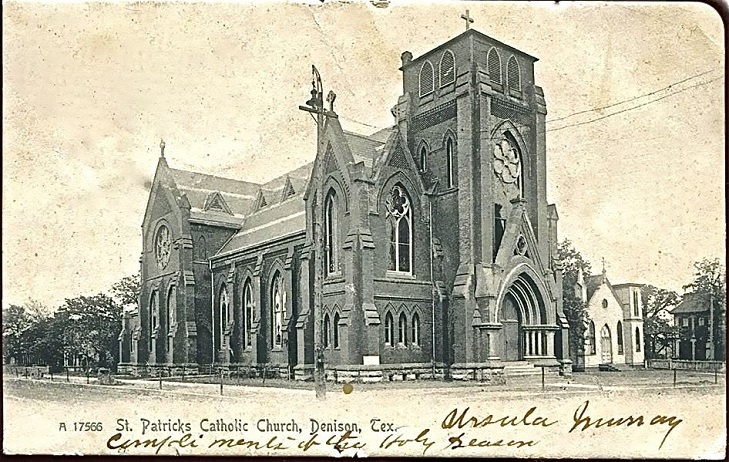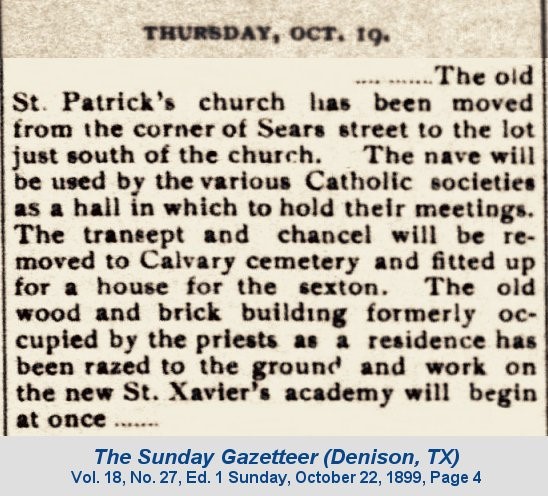|
St. Patrick's Catholic Church Denison, Texas   Although
the above picture of St. Patricks Catholic Church was not designed to
be a Christmas card, it was used as such by the sender, Ursula Murray,
in 1905. Below her signature she wrote "Compliments of the Holy Season." She
wrote on the front of the card because only an address was allowed on
postcard backs until that postal regulation was changed on March 1,
1907.
Note the relatively small white building to the right of the grand cathedral. The building was never used as a rectory. It was a church, but it was not built in 1877. It was Denison's original Catholic Church, built in the summer of 1873. An article in The Denison Herald dated, June 25, 1972 contains the following sentence, "Parish growth being rapid, a second frame church was erected on the site of the present church rectory, 314 N. Rusk, in 1877." By the time Denison celebrated its centennial two mistakes of fact in that sentence had become accepted history: The first mistake is the assertion that a new church was erected in 1877. The construction that year was simply an addition to the original church. After a transept and chancel were added to the nave, the building was transformed into a Latin cross. You can see the outline of it on the Sanborn Fire Insurance maps of 1888, 1892, and 1897. The second mistake is that the location of the church shifted from Sears Street to Rusk Avenue in 1877. It actually remained on the NW corner of Sears and Rusk for another 22 years, until almost a year after the dedication of the new cathedral on December 11, 1898. Following that dedication the old church was renamed "St. Patrick's Hall" and was used for meetings and school functions.  The
old church was finally moved in October 1899. That date, coupled
with the early 1901 publication date of Frank M. Robinson's Industrial Denison,
dates the photo of St. Patrick's in Robinson's book to ca1900. As
explained in the clipping, only the nave (original building) went to
314 North Rusk. The transept and chancel (1877 additions) went to
Calvary Cemetery north of town, where they were converted into a home
for the resident sexton, Lee Burgess. About 7 months later The Sunday Gazetteer reported that Burgess lost his 6-months-old daughter to cystitis. Since births and deaths of natural causes usually occurred at
home in those days, it may be that little Hazel Marie Burgess both
entered and departed this world in the former transept of the old Catholic Church. By
the time he died six years later at age 35, Lee Burgess, who
moonlighted as a night watchman and deputy sheriff, had become the
sexton at Fairview Cemetery. It is unknown whether Calvary Cemetery ever acquired another resident sexton. I also don't know the ultimate fate of the sexton's house (a/k/a transept-nave) there. Reasons for the mistaken belief that the church moved to Rusk Avenue prior to 1899 could include the Denison bird's-eye-maps of 1886 and 1891. Both show an unidentified building facing Rusk in the same location that the old church would eventually occupy. But the building on those is the St. Patrick's Parochial School for Boys, established in 1884. In the mid-1890s it was moved to the NE corner of Burnett Avenue and Sears Street. The 1888 and 1892 Sanborn maps show the school on Rusk. The 1897 map shows it at its new location. The relocations of the school and the old church may have been planned in anticipation of the construction of the new St. Xaviers Academy on the northwest corner of Sears and Rusk in 1900-1901. Another step taken by the church in anticipation of a new St. Xaviers was the acquisition of a new rectory or parsonage. The old rectory at 305 West Sears was demolished in 1899 to make way for the new academy. More than a year earlier, in April of 1898. Father Crowley bought the house at 216 W. Sears, adjacent to the new cathedral on its east side. That house served as the rectory for about 12 years, until the new church burned on October 30, 1911. It was in that parsonage that young Tom Corcoran died while trying to salvage some of its contents. The east wall of the burning church collapsed onto the house before he could escape. The original church building on the south side of the cathedral survived the conflagration. After the fire on the morning of October 30, a group of parishioners met later that night in the old church to discuss plans for erecting a new one. At the meeting Father Donoho, who had assumed the pastorate of St. Patrick's less than 6 months earlier, reminded his parishioners that he was now without a home, and the first order of business should be the construction of a new parsonage to replace the one just destroyed by fire. At Tim Murphy's suggestion they agreed to build a new rectory on the site of the 1873 church, the building in which they were then meeting. The old church would be moved to the rear of the lot, and the rectory would be constructed in front of it. The 1914 Sanborn map shows the old church rotated 90 degrees and still standing at the rear of the lot behind the new rectory; it is labeled "chapel". Sometime between 1914 and 1930, when the next Sanborn map was drawn, the 40 years old chapel disappeared. Whether it was razed, moved or burned is not known. In the 1915 Denison City Directory the address of the new rectory is 318 N. Rusk and the address of the rebuilt cathedral is 322 N. Rusk. St. Patrick's Catholic Church History Susan Hawkins © 2024 If you find any of Grayson CountyTXGenWeb links inoperable, please send me a message. |